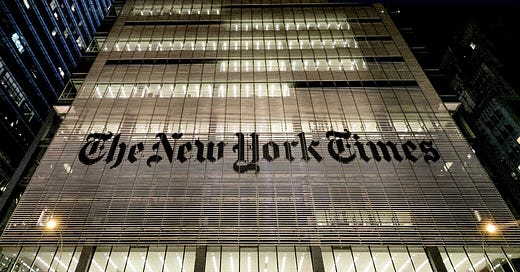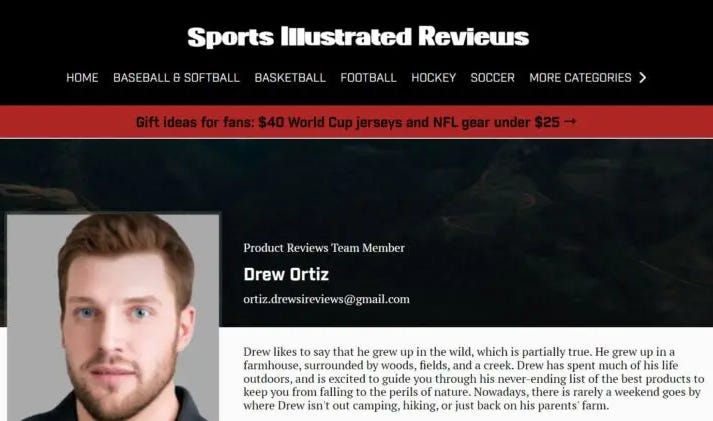The Fake News Blues
In a world full of misinformation, this company's trustworthiness has never been more critical.
Like many kids, I grew up dreaming of being a professional basketball player. But with a 5-foot-8 dad and a 5-foot-5 mom, it became clear that if I wanted to be involved with sports for a living, I’d have to write about it rather than participate in it.
I fell in love with the idea of being the next great sports writer. I made my parents subscribe to Sports Illustrated for years, and every week I’d run to the mailbox to get the newest issue, which I’d read cover to cover, starting with Rick Reilly’s Life of Reilly column on the back page.
That passion continued on through college. I graduated from the University of Maryland’s Philip Merrill College of Journalism and got a job as a sports reporter for the Hanover Evening Sun in Hanover, Pennsylvania, a sleepy town in southcentral Pennsylvania better known for being the snack food capital of the U.S. (home of Utz potato chips and Snyder’s pretzels).
The financial crisis whipsawed me out of the gig after nine months and set me on a different professional course, though still putting my degree to good work.
All of that to say that I was saddened when Sports Illustrated got sold in 2018 to Meredith Corporation as part of its acquisition of Time Inc. — and subsequently sold for parts to the company now known as Arena Group (AREN).
I was sure that at the very least, Sports Illustrated would continue putting out a product of reasonable quality, written by humans.
What I never saw coming was exactly what happened next: The company quickly got gutted in 2019, with half of the newsroom getting laid off. That productivity was quietly replaced with AI-generated articles, as media company Futurism discovered last month, writing:
There was nothing in Drew Ortiz’s author biography at Sports Illustrated to suggest that he was anything other than human.
“Drew has spent much of his life outdoors, and is excited to guide you through his never-ending list of the best products to keep you from falling to the perils of nature,” it read. “Nowadays, there is rarely a weekend that goes by where Drew isn’t out camping, hiking, or just back on his parents’ farm.”
The only problem? Outside of Sports Illustrated, Drew Ortiz doesn’t seem to exist. He has no social media presence and no publishing history. And even more strangely, his profile photo on Sports Illustrated is for sale on a website that sells AI-generated headshots, where he’s described as “neutral white young-adult male with short brown hair and blue eyes.”
Arena Group responded by taking the articles down and firing COO Andrew Kraft and president Rob Barrett. But the reputational damage was already done.
Sadly, this isn’t an isolated incident. Tech website CNET laid off workers and began to use AI to create content. Per an article back in June from The Verge:
CNET has also gone back and updated the dozens of previously published stories generated using AI systems that triggered backlash in January.
Of the more than 70 stories published over the course of several months, CNET eventually issued corrections on more than half. Some contained factual errors, while others were updated to replace “phrases that were not entirely original,” suggesting they may have contained plagiarized material.
Stories now include an editor’s note reading, “An earlier version of this article was assisted by an AI engine. This version has been substantially updated by a staff writer.”
BuzzFeed (BZFD) got in on the action as well, laying off 15% of its 1,500 workers, shuttering its news division, and announcing it would be “leaning into AI” to produce its content.
And even Gannett (GCI) — the media conglomerate that owns USA Today, the Detroit Free Press, the Indianapolis Star, the Cincinnati Enquirer, and the Columbus Dispatch, among others — got dinged for its use of AI.
The Columbus Dispatch was using an AI service called Lede AI to produce high-school sports stories. But its lack of human touch quickly showed through when one of its articles was sloppily published without AI noticing the [[WINNING_TEAM_MASCOT]] and [[LOSING_TEAM_MASCOT]] placeholders:
In short, it’s never been harder to tell if the content you’re consuming is legitimate. According to research firm Forrester:
As misinformation fueled by AI-generated images, deepfakes, and faux human influencers rises — 81% of online adults in the US, UK, Spain, and Italy agree that there is a lot of fake news and misinformation on social media — news outlets like the BBC will become coveted sources of information.
Even 63% of adults in China agree that social media is full of fake news and misinformation. More from Forrester:
Due to these circumstances, there will be a much-needed rebound for trust in media. This resurgence must serve as a bellwether for social media and tech firms to prioritize source credibility and data provenance. As the line between real and fake blurs further, organizations must double down on marketing activities aligned to tier-one media and ensure that they are seen as reliable and trusted sources for journalists, buyers, investors, and other critical audiences. Brand safety concerns should also encourage orgs to dissociate from media that fails to quell the tide of fake news.
At the same time, more attention will be paid to the media heading into what looks to be one of the most polarizing U.S. presidential elections of all time, not to mention the Summer Olympics in Paris.
And all of that will push shares of New York Times (NYSE: NYT) higher.
The company, which traces its origins back to 1851, has roughly 11 million paid and digital subscribers. Subscriptions account for 65% of its revenues, with advertising making up the remaining 35%.
Its product suite has expanded beyond its flagship newspaper and into sports (The Athletic), cooking (NYT Cooking), puzzles (NYT Games), audio (Audm), and reviews (Wirecutter).
Earlier this year, NYT announced plans to buy back $250 million of its stock, or 3% of its outstanding shares. It’s currently sitting on a $590 million pile of cash and has zero (as in, $0.00) debt. Plus, NYT sports a 1% yield, and the company has raised its dividend five straight years.
The company is also growing: Revenues are up 36%, EBITDA (a measure of profits) is up 45%, and earnings per share are up 115% since 2020.
As investments go, NYT shares aren’t a bargain, trading at 18 times forward EV/EBITDA estimates and 31 times price-to-earnings (versus roughly 20 times for the S&P 500).
On the other hand, that premium valuation is warranted: Going back to 2018 — the period since NYT began to lean heavily into digital subscriptions — NYT shares have traded at an average EV/EBITDA multiple of 21 times and an average P/E ratio of 41.
So they are moderately cheaper today than they have been over the past five years, during which the company has added 8.8 million digital-only subscribers.
With people desperately in search of a trustworthy news source and multiple bullish catalysts heading into 2024, New York Times (NYSE: NYT) is a smart speculation up to $50 a share. Caveat emptor, this is not investment advice, yadda yadda yadda. If you do choose to invest, do so with a 25% trailing stop.






The New York Times is a dishonorable purveyor of woke, left-wing propaganda--anti-American and antiSemitic. Its sorry state today is simply unbelievable compared to what a fine organization they were 40 years ago. They have openly admitted to slanting the news to meet the views of their subscribers, progressive left wing flakes. The whole thing, like the Ivy League, may be about to fall part. One can pray!